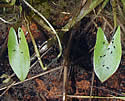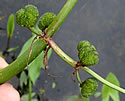Sagittaria cuneata (Arum-leaved Arrowhead)
| Also known as: | Northern Arrowhead |
|---|---|
| Genus: | Sagittaria |
| Family: | Alismataceae (Water Plantain) |
| Life cycle: | perennial |
| Origin: | native |
| Habitat: | part shade, sun; ponds, marshes, lake shores |
| Bloom season: | July - September |
| Plant height: | 4 to 24 inches |
| Wetland Indicator Status: | GP: OBL MW: OBL NCNE: OBL |
| MN county distribution (click map to enlarge): |  |
| National distribution (click map to enlarge): |  |
Pick an image for a larger view. See the glossary for icon descriptions.
Detailed Information
Flower: 


![[photo of flowers]](/udata/r9ndp23q/pd/sagittaria-cuneata-2-4-t.jpg) Flowers are whorled in groups of 3 in a spike-like raceme at the top of a naked stem. There are usually both male and female flowers on the same stem, with whorls of males above the females. Both genders are ½ to ¾ inch across with 3 broad, paddle-shaped, white petals and 3 small, pale green to brownish sepals behind the flower. Male flowers have a group of yellow stamens in the center. Female flowers have a bulbous green center, covered in tiny carpels.
Flowers are whorled in groups of 3 in a spike-like raceme at the top of a naked stem. There are usually both male and female flowers on the same stem, with whorls of males above the females. Both genders are ½ to ¾ inch across with 3 broad, paddle-shaped, white petals and 3 small, pale green to brownish sepals behind the flower. Male flowers have a group of yellow stamens in the center. Female flowers have a bulbous green center, covered in tiny carpels.
![[photo of bracts and sepals]](/udata/r9ndp23q/pd/sagittaria-cuneata-26-t.jpg) At the base of the whorl are 2 or 3 narrowly triangular to lance-shaped bracts that are sharply pointed at the tip, and ¼ to 1½ inches long, often nearly as long as the flower stalks. The bracts shrivel up quickly, the brown, papery remains persisting through fruiting. A plant has 1 or more flowering stems, each with 2 to 10 whorls of flowers. The flowering stem may be taller or shorter than the basal leaves and is sometimes branched at the lowest whorl of flowers.
At the base of the whorl are 2 or 3 narrowly triangular to lance-shaped bracts that are sharply pointed at the tip, and ¼ to 1½ inches long, often nearly as long as the flower stalks. The bracts shrivel up quickly, the brown, papery remains persisting through fruiting. A plant has 1 or more flowering stems, each with 2 to 10 whorls of flowers. The flowering stem may be taller or shorter than the basal leaves and is sometimes branched at the lowest whorl of flowers.
Leaves and stems: 


![[photo of arrowhead-shaped leaves]](/udata/r9ndp23q/pd/sagittaria-cuneata-12-t.jpg) A rosette of toothless, hairless basal leaves surrounds the flowering stems. Emersed leaves are up to 3½ inches long, to 2 inches wide, typically arrowhead shaped, with the basal lobes shorter than the remainder of the blade, or sometimes egg to somewhat heart-shaped, without the basal lobes. Emersed leaves are long stalked and may be erect, rising above the water, but often floating on the surface.
A rosette of toothless, hairless basal leaves surrounds the flowering stems. Emersed leaves are up to 3½ inches long, to 2 inches wide, typically arrowhead shaped, with the basal lobes shorter than the remainder of the blade, or sometimes egg to somewhat heart-shaped, without the basal lobes. Emersed leaves are long stalked and may be erect, rising above the water, but often floating on the surface.
![[linear basal leaves, on stranded plant]](/udata/r9ndp23q/white/sagittaria-cuneata-arum-leaved-arrowhead_0817_132943-t.jpg) Submersed leaves are ribbon-like, flat and linear with sharply pointed tips and may grow to 18 inches long in deeper water. Flowering stems and leaf stalks are hairless.
Submersed leaves are ribbon-like, flat and linear with sharply pointed tips and may grow to 18 inches long in deeper water. Flowering stems and leaf stalks are hairless.
Fruit: 
![[photo of fruit]](/udata/r9ndp23q/pd/sagittaria-cuneata-24-t.jpg) Fruit is a globular head, about ½ inch in diameter, of beaked seeds. The beak is erect at the top of the seed
Fruit is a globular head, about ½ inch in diameter, of beaked seeds. The beak is erect at the top of the seed
Notes:
Of the 6 Sagittaria species in Minnesota, Arum-leaved Arrowhead most closely resembles Broad-leaved Arrowhead (Sagittaria latifolia), but in miniature. The arrowhead-shaped leaves differ with S. latifolia having basal lobes that are usually about as long as the remainder of the blade and the seeds have a horizontal beak, where S. cuneata has shorter lobes and an erect beak. This is the predominant Sagittaria species in drainage ditches in western Minnesota and the Dakotas.
Native Plant Nurseries, Restoration and Landscaping Services ↓
More photos
 Arum-leaved Arrowhead plant
Arum-leaved Arrowhead plant Arum-leaved Arrowhead plant, barely submersed
Arum-leaved Arrowhead plant, barely submersed Arum-leaved Arrowhead pond habitat
Arum-leaved Arrowhead pond habitat floating leaves, in drainage ditch habitat
floating leaves, in drainage ditch habitat a branched flowering stem
a branched flowering stem
Photos by K. Chayka taken in Lake County. Photos courtesy Peter M. Dziuk taken in Lake County and in North Dakota.
Comments
Have you seen this plant in Minnesota, or have any other comments about it?






